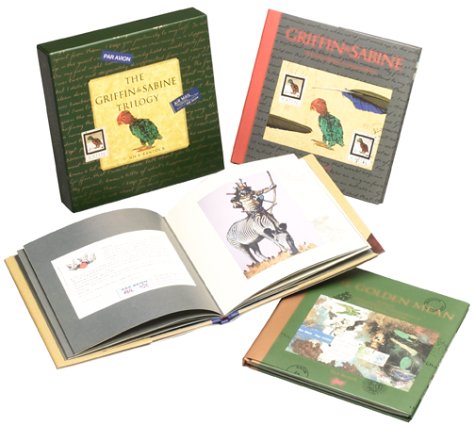The Griffin & Sabine Trilogy: Griffin & Sabine, Sabine's Notebook,
The Golden Mean
Nick Bantock
Fiction (romance, mystery)
Reviewed by: Breanne Siska
Review posted: 12/26/03
Be prepared to read books like you have never read them before. Nick
Bantock's stunning trilogy of books, Griffin & Sabine, Sabine's
Notebook and The Golden Mean, are probably unlike any other books
that you've even seen. Contained within the pages of these books are
the mailed correspondence between Griffin Moss, a man from London who
designs postcards, and Sabine Strohem, a woman from the South Pacific
who mysteriously sends Griffin mail saying that she can see his work,
as he does it. Intrigued by the very notion of strangers thousands
of miles apart somehow knowing each other, the two characters write
to each other with an interest that blossoms into love.
The story concept is enough to make the books worthwhile, but the
method of delivery just heightens it so much more. Each postcard,
each letter, each bit of mail is included in book itself, with the
front on one side of a page and the back on the opposite side,
allowing for the reader to reach into each envelope and take out each
page. The reader is able to see Griffin and Sabine's handwriting and
typewriting, giving the books the vouyeristic sense of reading other
people's mail. The reader almost entirely forgets that Griffin and
Sabine are fictional characters.
 Bantock's ecclectic artistry works with the storyline to create a
feast for the eyes as well as the imagination. Hard to believe that
the man both wrote and illustrated the book. Griffin's more
contemporary style of painting and Sabine's collage-like stamp
designs carry over into each of their individual cards to give the
reader a subtle look into both character's psyche. (Note: available
are the Griffin and Sabine blank notecards, which of course use some
of the fabulous artwork from the books.)
Bantock's ecclectic artistry works with the storyline to create a
feast for the eyes as well as the imagination. Hard to believe that
the man both wrote and illustrated the book. Griffin's more
contemporary style of painting and Sabine's collage-like stamp
designs carry over into each of their individual cards to give the
reader a subtle look into both character's psyche. (Note: available
are the Griffin and Sabine blank notecards, which of course use some
of the fabulous artwork from the books.)
The trilogy starts off with Griffin & Sabine, where the two get to
know each other and realize their own need for the other. Sabine's
Notebook continues their long-distance romance of letters, with
Griffin going on a journey of self-discovery while Sabine lives in
his London loft awaiting his return, but ends with a confounding
twist. The Golden Mean concludes the trilogy, with Griffin and
Sabine's lives threatened by a strange man who somehow knows of their
letters, and their escape of his influence and into their own world
together.
The books are short enough to be read fairly quickly, but don't think
that the characters are at all shallow. The emotions of these two
characters is heartfelt and deep, and their histories and personal
insights are evident even until the third book. The reader could
easily spend as much time on reading the letters as one could pouring
over the wonderful artwork of these novels.
These books are a wonderful addition to anyone's library. I highly
doubt they will ever have a paperback edition, so be aware that you
will have to pay hardcover prices for each book, although buying them
as a boxed set generally will drop the cost. Although the trilogy is
ultimately a romance, it's not only women that can enjoy them-- I do
have several male friends that are complete fans of the books.
(Final note: Bantock originally wrote the series in the early 1990s,
and then decided to write a second trilogy a decade later, consisting
of The Gryphon, Alexandria, and The Morning Star, the last of which
was published in late 2003. Although at the time of writing this
review I have not yet read The Morning Star, based on the first two
books I can say that Bantock has really not succeeded. He introduces
more characters that unfortunately aren't really given the chance to
be developed within the relatively short spanse of the books.
Bantock is entirely too vague about the supposed mystery that is the
reason behind Griffin & Sabine corresponding to these two lovers in
the first place. Those who fall madly in love with the first trilogy
might be interested in reading the second trilogy just for the sake
of saying they read it, but it's my opinion is that Bantock should
have just let well enough alone and not bothered with a second
trilogy.)
|




 Bantock's ecclectic artistry works with the storyline to create a
feast for the eyes as well as the imagination. Hard to believe that
the man both wrote and illustrated the book. Griffin's more
contemporary style of painting and Sabine's collage-like stamp
designs carry over into each of their individual cards to give the
reader a subtle look into both character's psyche. (Note: available
are the Griffin and Sabine blank notecards, which of course use some
of the fabulous artwork from the books.)
Bantock's ecclectic artistry works with the storyline to create a
feast for the eyes as well as the imagination. Hard to believe that
the man both wrote and illustrated the book. Griffin's more
contemporary style of painting and Sabine's collage-like stamp
designs carry over into each of their individual cards to give the
reader a subtle look into both character's psyche. (Note: available
are the Griffin and Sabine blank notecards, which of course use some
of the fabulous artwork from the books.)